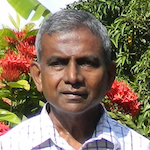The UNP Mob Vs The Judiciary (11 June ’83)

In Jayewardene’s quest to become all-powerful, he tried to keep up an appearance of liberal democratic norms. He had his A team to look after legislation, appointments and securing compliance through gentlemanly persuasion. This group was from the upper class with a veneer of liberal culture. The B team were the fixers openly associated with gangs of hoodlums.
Despite all the battering the Supreme Court was still not adequately, submissive it seemed. On 8th June 1983 a three-judge bench comprising B.S.C. Ratwatte, Percy Colin-Thome and J.F.A. Soza delivered a judgement in the case where Mrs. Vivienne Goonerwardene, who and her husband Leslie had been senior members of the LSSP, had complained of wrongful arrest and degrading treatment by the Kollupitiya Police. The court conceded wrongful arrest, but held that the degrading treatment alleged, had not been substantiated by the evidence. It was a minimal judgement.
On 11th June, the UNP B-Team went into action. A large crowd arrived in vehicles with banners and staged noisy protests outside the residences of the judges. The judges telephoned the Police who failed to respond for a long time. Even the emergency lines to Police HQ seemed to have gone dead just then. Jayewardene was then abroad. Gentlemanly arm twisting of judges is one thing, but this brazen attack on symbols of civilised society, was another. Protests started mounting. The people were clear that JSS, the UNP trade union organised by Cyril Mathew, provided the ruffians for the protest. As the result, witnesses were not prepared to give evidence to the Police; evidence was given anonymously or in confidence through third parties.
Herman Perera, the President of the Bar Association who had protested, received a threatening post card. On his appealing to Acting President Premadasa for police protection, the latter replied that it must have been a practical joke. Chief Justice Samarakoon himself gave the Police some names and other details for investigation. Of 10 vehicle numbers given, SSP Ignatius Canagaretnam of the CDB traced them all to vehicles owned by Ceylon Nutritional Foods, the Tyre Corporation and the buses among them to the CTB depots at Ratmalana, Kesbewa and Mattakuliya. All persons questioned provided alibis.
The most remarkable incident in the aftermath took place on 22nd June when the UNP sought a diversion. A young man by the name of Lakshman Fernando, also known as Kalu Lucky, went to the offices of the Island and handed over two statements, one in English and the other in Sinhalese, taking responsibility for having organised the demonstration, as a democratic protest against the Vivienne Goonewardene verdict. The English draft copy had been typed on an electric golf ball typewriter, then not commonly used, and had been corrected by two different hands. The following day the JSS complained to the IGP that it was being harassed by false and baseless complaints. The Attorney General, Shiva Pasupathy, the Press reported, was unable to make a ruling on whether to proceed against Kalu (Black) Lucky.
On 24th June, the Sun found Lucky at the Pannipitiya address he had given and he admitted that lawyers helped him to draft the statement. But a Police team led by Malcolm Cruz sent to the address the same day to question him said that they were unable to trace him. Further investigations by the Press revealed that Kalu Lucky was a leading member of the JVP in the 1971 rebellion (see Alles’s book – 29th suspect before the Criminal Justice Commission and sentenced to 5 years RI). He had subsequently joined the UNP and had campaigned for it. In 1983 he had a firm involved in servicing ships at the Colombo Port. The JVP in the meantime denounced him as a renegade.
Most interestingly, the Sun produced Kalu Lucky’s wedding photographs, where the couple was flanked on either side by two ministers. They were Justice Minister Nissanka Wijeratne and Youth Affairs Minister Ranil Wickremesinghe. It was quite clear whose protégé Lucky was and who set him up in the judges’ episode. His role in the judges’ affair was between his appearances at the Gangodawila magistrate’s court with seven others on charges of having murdered one Premasiri. One appearance was on 25th May 1983 and the next was scheduled for 3rd August.
The 3rd and 4th Amendments to the Constitution
How Jayewardene used a well-disposed judiciary is exemplified by one of his most undemocratic actions – the Fourth Amendment of November 1982. According to constitutional provisions, the life of the parliament in which the UNP commanded a five- sixths majority was to end on 4th August 1983. The 4th Amendment was one by which the Parliament extended its life a further six years ‘unless sooner dissolved.’
This was just after Jayewardene won the presidential election on 20th October 1982, the advanced date being made possible by the 3rd Amendment of 27th August 1982. This was when the SLFP was in disarray with Mrs. Bandaranaike deprived of her civic rights. Fur- ther confusion had been created by a suggestion by another presidential candidate, Dr. Colvin R. de Silva, that the SLFP candidate, Hector Kobbekaduwe, would, if elected, be unseated, on grounds of being the nominee of Mrs. Bandaranaike who had lost her civic rights and was subject to disabilities. 80.2% of those in the register voted, of which Jayewardene obtained 52.9% and Kobbekaduwe 39%.
At this stage Jayewardene discovered the ‘Naxalite Plot’ and proposed a 4th Amendment to avoid parliamentary elections altogether by going for a referendum – a simple majority in the referendum was to enable the UNP’s five- sixths majority in Parliament to continue for a further 6 years.
